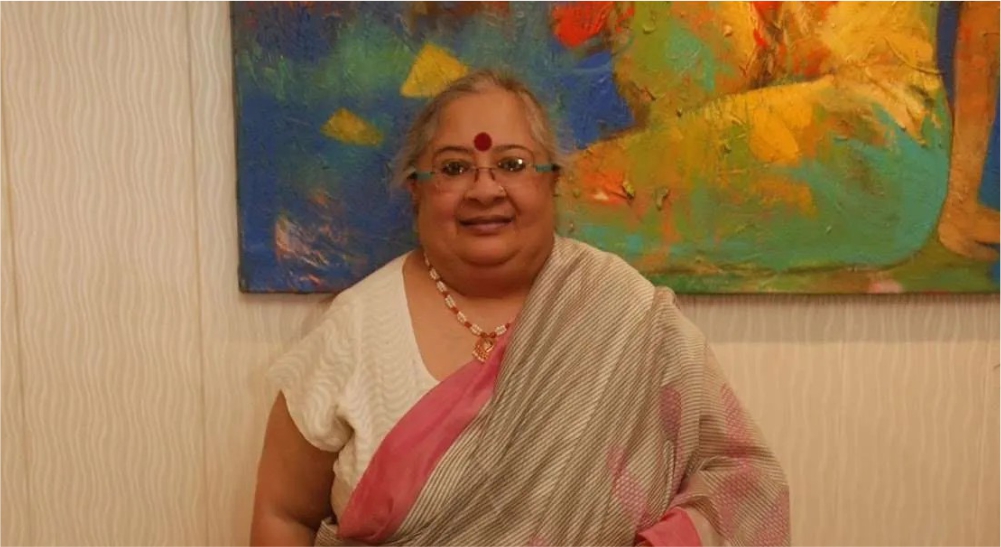 Â Motherhood a process of catharsis?
 Motherhood a process of catharsis?
By Alka Raghuvanshi
Pain is like water. No matter how much attempt to contain it, it finds a way to escape. In the context of artists and artistes, it is the manifestation of pain, anguish and torment that catapults their art to a level where it transcends mere technique and expertise to an intensity that renders it in the realm of the great.
The trail of grief and suffering is mysterious. It takes on journeys that logic challenges. It has the power to set one free for one has touched the dregs of sorrow and deep within one knows that if one can survive the worst, one can survive anything. It is up to you to make the choice. And it is this choice that ultimately defines who you are.
Artist Kavita Nayar is one such brave survivor who lost her young adult daughter Sakshi a decade ago in tragic circumstances and instead of letting it swamp her down, she allowed the anguish to wash over her and help bring about change into the lives of hundreds of young aspiring artists by supporting them to walk the difficult path of art.
Yet the umbilical cord is difficult to break away both ways – as a parent and as a child. In the case of Kavita, it appears in a myriad forms. This time it appears in the form of trees. She grapples with issues of the umbilical cord and the womb that finds itself into the strong nurturing hold of the tree – complete with a sturdy trunk and the crown made dense like a web of cords. The embryonic form however, is hidden in the airy comfort of the branches rather like the arms of the mother. In many ways this series have emerged from her earlier series based on the seed. The seed has indeed grown from the seed form into full blown tree yet it hides the womb inside but with a comfort that is sahaj or natural.
After painting flowers for nearly seven years after the incident that altered her forever, she says perhaps it manifest itself as trees sub-consciously and spontaneously as she had no conscious plan to create trees. But when they became trees, it was as if she was creating a child every day. “Just as an artist doesn’t create a masterpiece every day, yet finds immense contentment in creativity. My work keeps me alive, I could have become a recluse and unable to create, but I feel my work is indeed a gift from God,” says Kavita.
Like most artists Kavita has a series of works that are related so closely to her life that they are autobiographical. But then a lot of  it is related to what an artist sees and experiences. This series of etchings and prints have come purely intuitively and the spontaneous edge is evident. However, printmaking for sheer reasons of the technique can never be completely unplanned for one has to plan every layer in advance. “When you are pregnant everything is step by step. These series too are moving at a very gentle pace,” says Kavita.
In addition to the etchings and prints the artist has created an installation of a lotus pond with printed images of the flowers and zinc plates of lotus leaves . She shares the rather difficult process of the technique and the actual zinc plates alongside the final works. These are almost sculptural in character as the intaglios are made very painstakingly with acrylic sheets cut out in the shape of flowers. The installation in various layers is in varying heights from the ground level to two feet .As part of her series she has also created a form with rubbings from the texture of the bark of the tree on a pillar.
This series embodies the belief that life is harmoniously symbiotic. A seed is buried in a womb and nourished by the mother through the umbilical cord. This cord is firmly bound to the foetus like the verdant stem holding the lotus up to bloom. The umbilical cord is the bond between the foetus and the womb. It embodies the ancient truths of Mother Nature, of life, dependence and freedom.
Diffidence about sharing the embryonic feelings is something one is able to do with maturity that it is not something to hide but be open and share. Not that she feels that she will ever get over the grief. “Even if I am a 100 years old, I don’t think I will ever get over the pain and sorrow,” says Kavita. The umbilical cord holds strong as it is evident when this incident happened the pain obviously changed the artist forever. “It was god’s wish and she came into our lives and gave us so much happiness. Her death too had a purpose – for us to connect to so many children, otherwise she would have remained the centre of our universe. I feel it is a step towards evolution. I am very content with how it has all panned out.” says Kavita with a rare acceptance.
Dr Alka Raghuvanshi is an art writer, curator and artist and India’s first trained art curator. She has 26 books to her credit and has launched two art portals.


